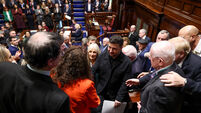Readers' Blog: Making the case for regulating the runway

Employment law has become synonymous with recognising the overlooked worker. Yet, one of the most pressing employment law crises is borne by those who are renowned for being at the centre of attention: Models.
Perversion and poverty are two infamous ingredients of the fashion industry. While the #MeToo movement has been a source of important empowerment for identifying abuses, insufficient attention has been paid to the systemic and structural causes of these wrongs. Underage modelling and payment structures are two means by which the relationships of dominance that facilitate abuse have been established.
Youth is excessively and obsessively valorised by the fashion industry. At the mere age of 14, Brooke Shields starred on the February 1980 cover of Vogue. At age 15, she fronted a Calvin Klein campaign in which she declared: “You want to know what comes between me and my Calvins? Nothing!”
The concerns that surround subjecting children to the pressures of a professional environment are not new, and as such, key players in the fashion industry have purportedly addressed them over the years.
In 2007, the Council of Fashion Designers of America recommended, and the British Fashion Council required, that designers use models who were at least 16 years old for runway shows. Yet Sofia Mechetner appeared in a Dior couture show aged 14 in July 2015. These discrepancies are part and parcel of the nature of these fashion codes being guidelines that are binding by weight of expectation rather than by law.
The link between #MeToo and the dangers of underage modelling have been touched upon by Steven Kolb, CEO and president of the CFDA:
“Young models are still developing. There can be a lack of the confidence, strength, experience, and maturity it takes to deal with the pressures of this work. The CFDA supports the recommendation of raising the minimum age — we want young models to have the time to come into their own so they feel safe and in charge in the workplace.”
These issues require robust recognition, the form of which should be a commitment to an 18-plus modelling standard. Such a standard was proposed by Vogue in its September issue, as part of Conde Nast’s new global vendor code of conduct. However, it was accompanied by an exception for any model who is the subject of an article, in which case the model will be both chaperoned and styled in an age-appropriate manner. This caveat requires us to accept a trend of social responsibility as a palliative for protection.
The fashion show economy has made modelling into a commodity business. Stardom escapes the majority of models who walk the runways; instead, a disposable culture pervades the industry. Unless you are one of a select few supermodels such as Gigi Hadid or Karlie Kloss, you will be burdened with an awareness that you are
replaceable. The question therefore becomes: If fortune is the correlative of fame, what is the correlative of function?
Many models work for free under the pretence that maximum glamour justifies the sacrifice of minimum wage. Their tenuous employment status as independent contractors is masked by a trend of working “for trade”. This arrangement is documented in a new book by academic Giulia Mensitieri, entitled The Most Beautiful Job in the World, in which workers receive vouchers for goods from the brands that hire them rather than monetary compensation. This leads to a situation in which fashion workers enjoy the perks but not the rights of a job — a Chanel handbag but no money for rent.
The short-term nature of most fashion careers has been an obstacle to unionisation. However, two associations are making ground in the effort to acknowledge modelling arrangements as employment relationships: Model Alliance in the US, and Model Law in France.
Affording models fundamental employment rights is a necessary step in preventing the shameful abuses unearthed by the #MeToo movement; ensuring basic protections for models in terms of fair pay and protection against harassment is a means of dismantling the infamous relations of dominance that persist in the fashion industry.
The aim of social movements is to change the way we see things, but only the law can transform these abuses from being seen as public relations crises to human rights violations. If we do not legislate for the prevailing culture of change, abuse will continue to be housed in ambiguity.
Creaghduff
Coosan Pt
Athlone










